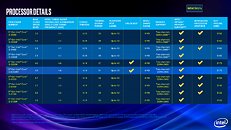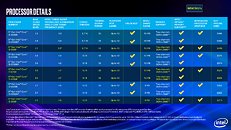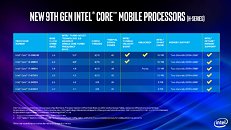Tuesday, April 23rd 2019

Intel Expands 9th Gen Core Desktop and Mobile Processor Families
Today, Intel launched the most powerful generation of Intel Core mobile processors ever: the new 9th Gen Intel Core mobile H-series processors, designed for gamers and creators who want to push their experience to the next level. "Our new 9th Gen platform is designed to delight gamers, creators and performance users by giving them more of what they want. We are bringing desktop-caliber performance with up to 5 GHz and 8 cores in a range of thinner systems and new level of connectivity with Wi-Fi 6 (Gig+) so users can game or create where they want," said Fredrik Hamberger, general manager of the Premium and Gaming Laptop Segments at Intel.
There are 580 million enthusiast PC gamers and 130 million PC-based content creators today who care about raw performance as much as they do responsiveness of their PC. They require PCs that can handle everything from demanding AAA games to taxing creative workloads like editing, rendering and transcoding massive 4K video - all while on the go. The 9th Gen Intel Core mobile processors deliver desktop-caliber performance in a mobile form factor and feature amazing performance; the fastest, most reliable wireless with Intel Wi-Fi 6 AX200 (Gig+); the most versatile wired connectivity with Thunderbolt 3; and support for Intel Optane memory technology.At the top of the stack is the 9th Gen Intel Core i9-9980HK processor, the first Intel Core i9 mobile processor with up to 5 GHz with Intel Thermal Velocity Boost, 8 cores and 16 threads, and supporting 16 MB of Intel Smart Cache. The 9th Gen Intel Core mobile processors are designed for the most demanding workloads to deliver:
New Desktop Processors
New additions to the 9th Gen Intel Core desktop processor family were also introduced today. The 9th Gen Intel Core desktop processor lineup now includes more than 25 total products with options ranging from Intel Core i3 up to Intel Core i9 with amazing performance and flexibility to meet a range of consumer needs from everyday productivity to gaming to content creation. The family also brings Pentium Gold and Celeron products to market for entry-level computing, giving consumers even more options to find the right desktop to fit their specific need and budgets. New capabilities include:
There are 580 million enthusiast PC gamers and 130 million PC-based content creators today who care about raw performance as much as they do responsiveness of their PC. They require PCs that can handle everything from demanding AAA games to taxing creative workloads like editing, rendering and transcoding massive 4K video - all while on the go. The 9th Gen Intel Core mobile processors deliver desktop-caliber performance in a mobile form factor and feature amazing performance; the fastest, most reliable wireless with Intel Wi-Fi 6 AX200 (Gig+); the most versatile wired connectivity with Thunderbolt 3; and support for Intel Optane memory technology.At the top of the stack is the 9th Gen Intel Core i9-9980HK processor, the first Intel Core i9 mobile processor with up to 5 GHz with Intel Thermal Velocity Boost, 8 cores and 16 threads, and supporting 16 MB of Intel Smart Cache. The 9th Gen Intel Core mobile processors are designed for the most demanding workloads to deliver:
- A full range of processors including Intel Core i5, i7 and the unlocked Intel Core i9-9980HK for even more performance.
- Up to 33% overall performance leap compared with a 3-year old PC.
- Up to 28% increased responsiveness.
- Continuous performance optimization with Intel Dynamic Tuning for all types of laptops.
- Play immersive AAA gameplay with up to 56% FPS improvement on games like "Total War: Warhammer II".
- Experience up to 38% faster turn time on games like "Civilization 6".
- Game, record and stream without compromise and broadcast HD live streams up to 2.1 times faster, gen-over-gen.
- Break the gigabit barrier with the latest Wi-Fi 6 standard running on the Intel Wi-Fi 6 AX200 (Gig+) solution offering almost three times faster throughput and up to 75% latency reduction - pair it with Wi-Fi 6 (Gig+) routers based on Intel technology to unleash a great gaming experience.
- Up to 54% faster 4K video editing versus a 3-year-old PC.
- With up to 1TB of total storage, Intel Optane memory H10 with solid-state storage will have the capacity users need for their apps and files.
- Up to 63% faster content creation versus a 3-year-old PC via Intel Optane memory H10 with solid-state storage versus a standalone TLC NAND SSD.
- Intel Wi-Fi 6 (Gig+) lets you share your 10GB multimedia files in less than one minute (almost three times faster than standard 2×2 AC Wi-Fi). When connected to a new Wi-Fi 6 (Gig+) router powered by Intel technology it is now possible to create, edit and share faster than ever before.
New Desktop Processors
New additions to the 9th Gen Intel Core desktop processor family were also introduced today. The 9th Gen Intel Core desktop processor lineup now includes more than 25 total products with options ranging from Intel Core i3 up to Intel Core i9 with amazing performance and flexibility to meet a range of consumer needs from everyday productivity to gaming to content creation. The family also brings Pentium Gold and Celeron products to market for entry-level computing, giving consumers even more options to find the right desktop to fit their specific need and budgets. New capabilities include:
- Up to 47% more FPS while gaming.
- Up to 2.1 times faster video editing compared with a 5-year old PC for 4K and 360 video editing experiences.
- Intel Wi-Fi 6 (Gig+) with gigabit Wi-Fi speeds delivering almost three times faster than standard 2×2 AC, and 40% faster than Intel Wireless-AC (Gigabit).
- Up to 8 cores and 16 threads, up to 5 GHz maximum turbo frequency, up to 16 MB Intel Smart Cache and up to 40 platform PCIe lanes.





46 Comments on Intel Expands 9th Gen Core Desktop and Mobile Processor Families
"Intel client commercial" means CPUs put into OEM desktops.
DIY desktop processors for gamers/enthusiasts have a separate roadmap. If needed, Intel should be able to provide 10nm CPUs for enthusiast market (it's tiny).
Personally I think it's fake, but it actually looks fine.
Intel won't be able to counter 16-core Ryzen with this, but that's a marketing excercise. Everything else is within range.
Ice Lake-U in May is a fantastic information. It'll be interesting to see how limited 10nm supply is.
Intel has the brand, the features, the ULV market, the ecosystem and - obviously - partnership contracts.If Zen 2 gets 16 cores at per-core level of 9900K, it'll need a separate 8-pin on the SoC, because AM4 will melt from the current needed.
Lets say they'll manage to keep the 2700X single-core performance and that 7nm DUV is 30% more efficient.
2700X all-core boost draws around 170W. 170*2*0.7 = 238. You know... AMD once had a CPU with TDP like that. It didn't end well for them.
As for HEDT: no one buys it anyway. Who cares?
A 2700X system from the wall only pulls about 190 lulz.
www.techpowerup.com/reviews/AMD/Ryzen_7_2700/17.html
www.techpowerup.com/reviews/AMD/Ryzen_7_2700X/18.html
After OC both CPUs draw roughly the same (with similar performance as well). But 2700X gets awfully close on its own. And that's the power draw we should look at, since it corresponds to performance that Ryzen is praised for.
Looking at the specs and idle figures, I'd say the rest of the PC draws around 40W. This leaves 170W for the Ryzen.
If you don't believe TPU reviews, here's another one:
www.guru3d.com/articles-pages/amd-ryzen-7-2700x-review,7.html
Oh my. Are you one of the people that believe Ryzens stay under the TDP and only Intel CPUs boost beyond? Poor you...
Keep in mind workstation and server cost for Intel is huge. Rome is already better per socket.
Not sure where you draw your data from, but powers you mention are a joke. 7nm TSMC gives 50% less power requirements. So, even if AM4 was limited to 300W, they could double the core count power-wise.
Ok, ABSOLUTE worst case scenario (blender/cinebench), and we'll even use the guru3d link. Look at CPU+SoC power in wprime (101). Look at the increase from wprime to cinebench in the graph above (33). Add the difference. 101+33= what? SURE AS SHIT AIN'T 170! Typical loads are gonna be like 105-115.
Bye, ban yourself from using the internet.
AMD might gaining (so needed) market share is all that can come out of it.
Note how Ryzen gains are largely driven by Intel chip shortages.
Of course, if AMD fails to catch up, nothing changes. Intel will slowly keep loosing server market.
Anyway, in guru3d test 2700X system pulled 199W in Cinebench, getting 1828 points.
8700K system pulled 150W getting 1402 points.
Now, you tell me, based on HWiNFO readouts, that the rest of the system draws around 55W under load.
That means 8700K itself used 95W (its TDP! ding ding ding!).
This also means 2700X itself used 144W (not exactly its TDP).
Moreover,
1802/144 = 12.7 [pts/W]
1402/95 = 14.8 [pts/W]
which makes the i7 quite a bit more efficient.
Do you agree with all that? :-)
I don’t see anything remotely close to 199W for a 2700X on the chart above. Even a 12c/24t TR can’t get there. Intel’s “95w” 9900K does look a little funny though.
www.anandtech.com/show/13400/intel-9th-gen-core-i9-9900k-i7-9700k-i5-9600k-review/21
And no, Intel will not be dead anytime soon. They still have big volume and the supply chain advantages, not to mention long-standing relationships with OEMs.
On the other side it's wccf, and I don't remember if their leaks have ever come remotely true.
It has been rumored for a while that Intel will be prioritizing server and ultra low voltage chips on 10nm, and if it's accurate that 10nm never will be widely deployed, then I'm fine with it as long as HEDT is included. Low-end and lower mid-range CPUs don't really need 10nm yet, so if the 10nm production volume will remain limited, it's better to focus on those chips that need the new node.
What remains unclear to me is what changes Comet Lake (and "Rocket Lake") will bring. Will this be another tweaked Skylake, or is it a backported Ice Lake/Sunny Cove?
But this 1% has to make sense.
At the moment enthusiast segment likely is profitable - even if small compared to OEM.
If AMD forces the prices down, Intel won't be interested anymore. They won't fight for the profit margin that AMD has right now.
Intel makes a lot of stuff. They can easily enter new markets. They'll find a better investment.We really don't know what "limited" means - other than the fact that Intel simply can't replace all their products with 10nm successors.
It could turn out that Intel 10nm will outsell AMD 7nm anyway.
If AMD's market share grows, they'll be faced with the same problem.
Also, Intel is pretty deeply committed to ship Ice Lake-SP, which is already postponed. Canceling it would have huge financial consequences for Intel, so making it even if it means eating up most of the 10nm capacity is probably the best idea, and the best use of "limited" 10nm production volume.